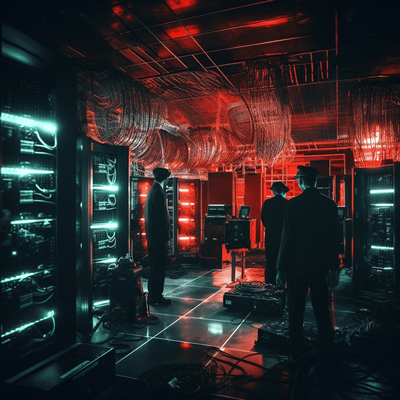IBM AIX Interview Questions & Answers
In this blog, I aim to provide information and knowledge regarding IBM AIX interview questions and answers as a means of helping you pass an interview successfully my sincerest hope is that it aids your discussion!
IBM’s AIX operating system runs across various computer platforms and is known for being robust yet dependable and adaptable enough to manage even the most demanding workloads and applications.
AIX excels at managing multiple activities and processes due to its multithread capability; complex multi threaded programs like databases or scientific simulations run smoothly on it.
System Performance Monitor offers tools and utilities for efficiently monitoring system performance, helping applications operate seamlessly.

1. What is the purpose of an operating system about hardware?
An operating system serves as an interface between the user and the hardware, allowing users to communicate with their hardware.
2. How is the kernel related to the functionality of an operating system?
The kernel is the heart of an operating system, as it is responsible for its functionality, if the kernel fails, the operating system may crash or need to be rebooted.
3. What steps can be taken to enhance the performance of IBM AIX?
To enhance the performance of IBM AIX, users can utilise IBM’s specially tested hardware, such as the IBM P series for AIX environments and the IBM Z series for mainframes, additionally, users can optimise their CPU processing through the high compression quality of the IBM Power System.
4. Compare the popularity and dependency of different Unix flavours in the market.
Some Unix flavours have gained popularity, they remain hardware dependent and proprietary.
IBM AIX remains an essential player in the market as a solid and versatile operating system that has seen growth over the past 30 years.
5. What advantages does AIX offer for enterprise business computing?
AIX offers advantages for enterprise business computing, such as advanced system security features, efficient resource utilisation through virtualisation technologies like LVM, reduced administrative costs with the ability to run multiple applications on one machine, and support for the latest hardware advancements.
6. When was the first version of AIX, AI X 1.0, released?
AI X 1.0 was first released in 1986.
7. How have the hardware and software combinations of AIX evolved?
The hardware and software combinations of AIX have evolved, with new technologies and performance optimisations being introduced, as well as changes in hardware required to support new software.
8. What significant improvement was introduced in the Power Five server regarding virtualisation?
The significant improvement introduced in the power five server in terms of virtualisation was the ability to make changes to an LPAR without requiring downtime.
9. What challenges did users face when working with the Power Four server regarding making changes to an LPAR?
Users faced the challenge of requiring downtime to change an LPAR when working with the Power Four server.
10. Propose a solution to the challenge of requiring downtime to change an LPAR in a Power Four server.
One solution to the challenge of requiring downtime for making changes to an LPAR in a power four server is to upgrade to a power five server, which allows for making changes to an LPAR without downtime.
11. What feature of Power Six allows users to move an LPR live from one physical machine to another?
Live Partition Mobility (LTM).

IBM AIX Training

12. Explain how Live Partition Mobility can be helpful during maintenance work on Power Six machines.
Live partition mobility allows users to move an LPR live from one machine to another, enabling them to switch between devices during maintenance work, such as upgrading RAM, changing CPUs, or repairing motherboards.
13. Why did many people switch from Power Five to Power Seven instead of adopting new hardware immediately after the introduction of Power Six?
Many people switched from power five to power seven because it takes time for companies to adopt new hardware, which can take one year or longer.
14. What is a power-efficient model to replace the Power Six with improved performance and reduced power consumption?
A power seven model with improved performance and a 50% reduction in power consumption compared to power six.
15. Why did IBM introduce Power Six servers with unique features for each model?
IBM introduced power six servers with unique features for each model to carry the legacy of power five machines and maintain their popularity.
16. Compare the Power Seven servers with the Power Six servers regarding performance.
The power seven servers have a smaller disk size and are more compact than other models, allowing for more compact storage and performance.
17. Explain why the Blade Server is an economical solution for organisations.
The blade server is an economical solution for organisations because it consumes less power and offers better performance than purchasing giant machines to increase power consumption in a data centre.
18. What does IBM offer the three distinct hardware models?
The three distinct hardware models IBM offers are the IBM X series, IBM PCs, and IBM Z Series.
19. What is the purpose of an operating system?
The purpose of an operating system is to act as a bridge between the user and the hardware, allowing the user to communicate with the hardware using human readable formats.
20. Compare and contrast AIX and Solaris operating systems.
AIX and Solaris are both operating systems used for enterprise business computing.
AIX is known for its robustness and low resource consumption, while Solaris is not mentioned in the context but could potentially have its strengths and weaknesses.
21. What are the advantages and limitations of IBM’s virtualisation technique?
The advantages of IBM’s virtualisation technique include reduced costs, improved resource utilisation, and the ability to share resources between virtual machines.
The limitations include the need for a separate license for each device and limitations in code generation that require a minimum processor and memory requirement.

IBM AIX Online Training

23. What is a virtual machine migration that minimises downtime and maximises resource utilisation?
A virtual machine migration considers load balancing, resource availability, and network connectivity between machines, prioritise migrating virtual machines during low usage periods to minimise user impact.
Use live migration techniques and monitor resource usage to ensure optimal resource utilisation during the migration process.
24.What is the name of the seventh-generation hardware introduced by IBM?
The seventh generation hardware introduced by IBM is called power seven generation.

25. Explain the concept of AMS Active Memory Sharing Pools and its benefits for memory usage.
AMS active memory sharing pools provide more options for efficiently using memory resources by allowing access to free memory beyond the entitled capacity, ensuring good performance and business continuity.
26. What are the main differences between the Power Six and Power Nine generations regarding hardware offerings and system security features?
The main differences between the power six and power nine generations include the availability of 10 Gigabit Ethernet adapters and a Giga Fibre Channel interface in the power nine generation, as well as advanced system security features such as auditing levels and error reporting mechanisms.
27. What is virtualisation for a hypothetical organisation to improve resource management and reduce operational costs?
Virtualisation for an organisation can include infrastructure analysis, identification of virtualisation opportunities, resource allocation and mapping, implementation of virtualisation technology and tools, regular performance monitoring and optimisation, and training for IT staff on virtualisation best practices.
28. What are some tasks involved in administering an operating system in AIX?
Tasks administering an operating system in AIX include assigning IP addresses, adding routes, managing software, port bonding, network interface configuration, backup channel setup, job scheduling, and managing paging space.
29. Why is backing up the operating system important?
Backing up the operating system is essential to maintain a quarantine image and ensure complete restoration in case of any issues, it allows for easy recovery and minimises data loss.
30. How can a portable installation be performed for the operating system?
A portable installation can be performed for the operating system by using methods such as CD, VM, or virtual optical media to install the system, the PMO server can create a facility file that loads the image into the virtual CD ROM.
31. What are the different aspects of resource management discussed in the summary?
It includes managing insulation, collecting data, restoring backup optic lines, and using AI-based management for monitoring performance, such as memory, CPU, and IoT devices.
32. How can the installation process be improved to make it more efficient?
The installation process can be improved by leveraging concepts like peak starting networks in Linux and comm-creating solar to manage real-time installations, collection managers can be used to install exploits within or outside a single box from multiple ports from any location.
33. What is comprehensive for maintaining and managing the operating system in AIX?
A comprehensive for maintaining and managing the operating system in AIX should include regular backups, implementation of a portable installation method, resource management strategies, and utilisation of AI-based monitoring tools for performance optimisation.

IBM AIX Course Price


Srujana
Author